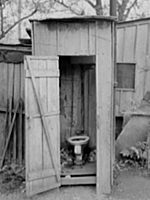
Barnes, J.Q.About | Story: Fields free of rocks | Abstract AboutMr. Barnes' recollections of a German and Italian prisoner of war camp in Hatch, New Mexico, during World War II.
Story: Fields free of rocksJQB: As far as I know them poor ol??? Germans weren???t allowed to do anything. They, and they were very uncooperative. I would, was talkin??? about this Adrian Ogas the other day and his cotton patch up there, his field. He, he still farms on the same farm. Anyway, the Germans were s-, assigned up there to take, to pick cotton for him an??? they weren???t doin???, they, maybe twin, twelve pounds a day or somethin??? like that so that the, the guard set a minimum that they had to pick in order to go. Well, he said the first two or three nights they, said they were there ???til midnight . . . RN: Um. JQB: . . . trying to get their allotment they???d set. But then, he said, ???But I???ll tell you, I???ve got the cleanest fields in New Mexico.????? Said there???s not a rock anywhere. RN: (Laughs) JQB: They picked up every rock an??? put it in the cotton sack and weighed it in. RN: (Laughs) JQB: Them poor old guys over the gin???s the one that had to clean it up. And then, uh . . . Abstract
Tape 1, Side A
During World War II, Mr. Barnes attended Hatch High School across the street from a prisoner of war camp housing German and Italian prisoners captured in North Africa. The prisoners worked on farms in the area and were not, according to Mr. Barnes, very efficient. The American soldiers stationed at the prison had good relations with residents of the Hatch area. In contrast, the "CC boys" at the Civilian Conservation Corps camp near Hatch before the war "had fights all over." Soldiers at the POW camp gave free jeep rides on certain days to residents who bought a twenty-five cent war bond stamp. The camp personnel also sponsored turkey shoots before Thanksgiving and Christmas and donated the proceeds to charity. Italian prisoners were allowed to go to the movies on Saturday afternoons, the consultant said, but not the Germans. The German prisoners were considered uncooperative, he said, and threw rocks in their cotton sacks to increase the weight when told to pick more cotton per day. One farmer said he got the rocks cleared out of his field anyway. Mr. Barnes said the POW camp included three buildings originally built by the U.S. Bureau of Reclamation when it was there in 1912-14 to construct Elephant Butte Dam. After the POW camp closed, the buildings were declared surplus property and were turned over to the Hatch public schools. Mr. Barnes describes how one of the adobe buildings finally disintegrated, or "melted," and a federal employee was sent to Hatch to investigate the missing building. The Italians were the more artistic, said the consultant, and created a twelve-foot plaster American eagle and shield to be displayed by the camp's flagpole. They also made a chandelier for their mess hall. (The chandelier has been donated to the New Mexico Farm & Ranch Heritage Museum.) One of the German POWs returned to Hatch after the war to show his family where he had been. Asked if the area residents were afraid of the prisoners, Mr. Barnes said all the local people were deer hunters with rifles. Only an escaped prisoner, he said, would be in danger. The consultant did not think prisoner of war labor did very much to alleviate farm labor shortages during the war. |

